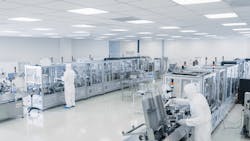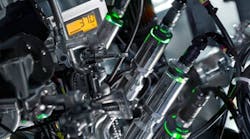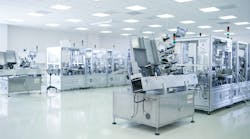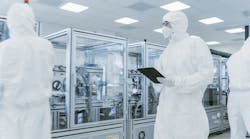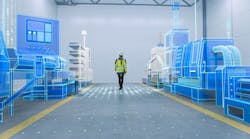Confronting pharma's hidden issue: equipment recapitalization
Pressure to do more with less hasn’t slowed today’s leading pharmaceutical engineers — but in a recent Unispace Life Science’s survey, many pointed to equipment recapitalization as an area of need, and opportunity. The clear consensus: It’s time to reimagine equipment recapitalization to better support changing business needs.
According to the Unispace Life Sciences Global Benchmarking report that surveyed nearly 200 global industry experts and interviewed senior leaders at 12 blue-chip pharma companies, equipment recapitalization is among the key investment and focus areas in the coming year for the engineering function at large life sciences organizations.
More and more pharma engineers are calling out the challenges of navigating a mix of old and new operations in legacy manufacturing facilities with aging equipment. They see the deep business value of moving from a reactive, ‘end-of-life’ equipment replacement strategy to a more proactive stance. The clock is ticking on making decisions — within five years, one-third of survey respondents say their current equipment could be obsolete amid changing business and production needs.
Pharma's hidden issue
However, accomplishing such a paradigm shift is easier said than done. A global CAPEX engineering director acknowledges, “Equipment recapitalization is a hidden issue in pharma. We all struggle with it as there are competing resources.”Right now, most life sciences organizations replace equipment at individual manufacturing sites primarily due to end-of-life (31%) and reliability risks (22%). Over the next five years, respondents spoke of bold plans to move away from recapitalization strategies based on equipment age and end of life, towards driving capacity, productivity and functionality.
Rather than replacing an asset simply because it’s worn out or has failed, they want instead to consider replacements based on capacity to spark business performance.
Although the benefits are clear, the ways to achieve them are not. To date only 15% of respondents have a global recapitalization strategy, although 28% plan to have one in the next five years.
Navigating roadblocks to equipment recapitalization planning
Most pharma engineering leaders are still limited by CAPEX concerns and the ongoing need to fast-track new products and new infrastructure. In an industry pressured by time-to-market metrics, production downtime poses a major threat to any company. Many worry that replacing equipment before end-of-life may be unnecessarily disruptive and even riskier than simply proceeding with an aging asset that still works.
Another roadblock comes from the ‘comfort zone,’ or familiarity with existing technologies. Site engineers and operators often prefer to repair or patch systems they’re used to using, rather than upgrading to newer assets and technologies they may not know as well.
There’s no silver bullet to identifying and implementing a recapitalization plan that reflects long-term business needs. The following questions can help you navigate equipment transitions while avoiding manufacturing disruptions.
-
How do you recapitalize automation systems that are integrated with equipment? If your company is like most, you extend the life of an asset and digital integration with vendor support and patching. For integrated software and equipment, 40% of survey respondents say they rely on third-party vendors for automation support “until equipment replacement is required.” In five years, that number shrinks to 30%, as more companies move to adopt an integrated approach that ensures all assets are up to date.
-
How do you replace equipment in certain areas? Over half (61%) use swing space for equipment replacements on a case-by-case basis. Capital engineering and manufacturing leaders say they prefer using swing space when available because it can significantly limit downtime in current production, while providing an opportunity for engineers and operators to gain experience with newer technologies without disrupting production processes.
Still, just one-quarter (25%) of respondents plan to allow for inactive swing space in the future; those who wouldn’t say they are concerned about the upfront costs of holding inactive space. The question becomes, could the potential long-term savings of swing space outstrip short-term costs?
-
Do you replace different lines according to different criteria? Yes, according to most respondents — 75% have replaced high speed filling lines and 80% have replaced visual inspection lines within the last ten years. In fact, pharmaceutical manufacturing engineers predicted the demand for equipment and ordered replacements two- three- years earlier than needed to fend off supply issues and production risks related to aging assets. Those who have not fully replaced units reported major enhancements, such as upgrading cameras and visioning tools on visual inspection lines.
By contrast, low-speed filling lines were replaced less often, because they experienced less wear and tear. Still, most companies had already replaced these units or planned to replace them in the next five years due to demand for manufacturing lines and technological advancements. As your team moves toward a global recapitalization plan, consider different criteria for evaluating assets in different environments.
-
How can you plan out CAPEX spend to maximize efficiency and minimize costs of aging or inefficient equipment? There’s no one right answer to this question. Shaping a global replacement strategy is crucial to optimizing CAPEX spend in a way that fuels your business priorities—one piece of equipment at a time.
Equipment recapitalization for more agile operations
Pharmaceutical companies are on the front lines of delivering lifesaving drugs to the market, not only quickly but safely and sustainably. By shaping a global equipment replacement plan, organizations can minimize downtime and drive production efficiency, while enabling engineers and operators to gain experience with newer solutions.
Together with integrated, updated facilities, creating a future-proofed equipment strategy is a critical step in paving the way for pharmaceutical success.
